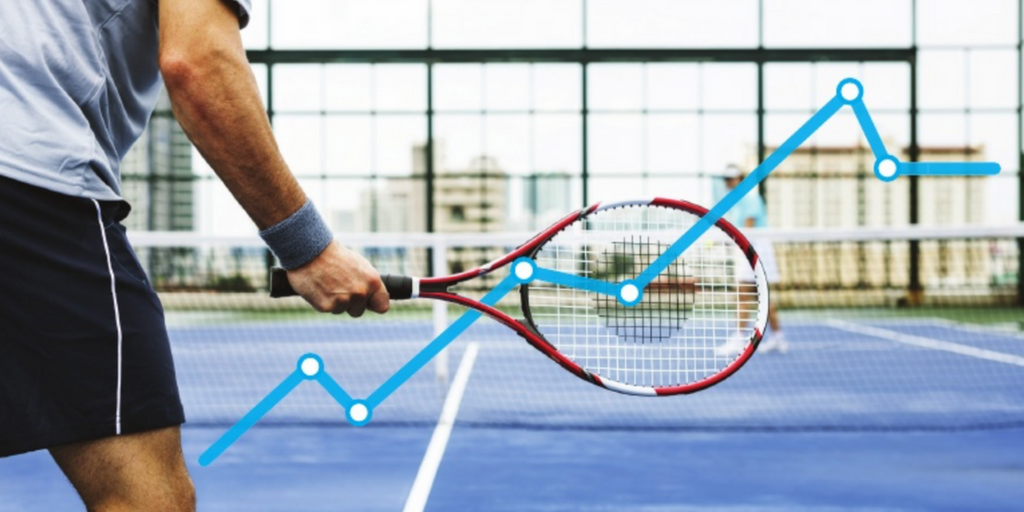By Craig Lambert (Courtesy of Tennis Industry Magazine)
Saturday nights in winter aren’t exactly “cash cows” for tennis facilities in Ottawa, Ontario. But at the Rideau Tennis Club, you may well see four courts humming with hotly contested singles matches between young players from the Sports Training Academy—athletes who play ITF and Futures events. “We’re leveraging the power of UTR
to set up highly competitive matches,” says Sean Sweeney, founder and CEO of the academy. “Our kids love it. I heard about UTR three years ago and immediately jumped on board.” The athletes like it, as does the Rideau Club: At $36 per hour, booking four courts from 6:30 to 8:30 on Saturday night generates $288 in revenue, plus ancillary income. The players pay $45 apiece for the match-play sessions.
"Unlike the widely-used rankings that award points based on which round a player reaches at a given tournament, UTR’s algorithm relies only on head-to-head results."
Universal Tennis Rating is an innovative system for calculating the skill level of tennis players on a scale from 1.00 to 16.50. The UTR scale, applicable worldwide, can rate everyone—males and females, young and old, beginners to top professionals. (At this writing, Andy Murray is rated 16.23, Serena Williams 13.26.) Unlike the widely-used rankings that award points based on which round a player reaches at a given tournament, UTR’s algorithm relies only on head-to-head results: Who did you play, and what was the score? It’s computed like a golf handicap—what course did you play, and how did you score?
Consequently, UTR is the most reli-able and accurate index of tennis skill available. Setting up matches with the UTR yardstick generates close play.When two players with UTRs within 1.0 of each other play (say, 9.53 and 10.12), the majority of the time they’ll have a competitive match—defined by UTR as 6-3, 6-4, or closer. When someone defeats an opponent whose UTR is 1.0 or more above their own, UTR defines that as an upset, which happens only about 3 percent of the time.
A Single Ranking System
With an estimated 2,700 ranking systems in use globally, tennis needs a “metric system,” a single worldwide yardstick for evaluating players. The simplicity, accuracy and consistency of UTR meets that need, and it is catching on rapidly. All ATP and WTA pros and college players have UTRs, as do many competitive juniors around the world.
"With an estimated 2,700 ranking systems in use globally, tennis needs a “metric system."
The system’s database includes more than 4 million results from 202 countries. UTR collects results from Tennis Canada, Tennis Europe, Great Britain’s Lawn Tennis Association, Tennis Australia and ITF tournaments. Seven USTA sections, including Northern California and Southern California, use UTR to seed their tournaments, and Northern California, the only section with access to its own results, pipes them into the UTR database.
Because it matches players so well by ability, UTR enables level-based play. This means putting athletes at a similar level of skill together, and ignoring age and sex differences. Why not have boys play girls? Why not have juniors compete with collegians or adults, as long as they’re evenly matched? UTR makes these competitive matches happen.
In a recent year, 38 percent of those who played a USTA junior event for the first time never entered one again, in large part due to the blowouts so common in age-graded events. The level-based play that UTR-based competition and seeding offers is a solution to this problem.
Level-Based Play
Salman Bader saw the power of level-based play a few years ago when he was director of junior tennis at the Cavalier Golf and Yacht Club in Virginia Beach, Va. “At tennis clubs, most kids don’t play tournaments,” says Bader. “How do you get them to play more?”
Bader created “junior tennis shoot-outs” during the noon to 3 p.m. slot on Sunday afternoons, typically “dead time” at Cavalier. Bader organized round-robin play for two groups of 16 players, whom he sorted into two levels using an early version of UTR. Each entrant played three randomly chosen opponents in their group for 30 minutes apiece. With 90 minutes of tennis per player, Bader could complete both levels in three hours.
Although kids tend to goof off in practice matches, the competitiveness of level-based contests seemed to raise their focus, according to Bader. Plus, whoever won the most games in each foursome received a small prize. The club charged each participant $15, so the three-hour event produced $480. Bader was so impressed with the effect of level-based play that he eventually joined the UTR staff, where he is now lead data manager. “We did the shootouts every Sunday for years,” he says. "It was a big success."
This article was originally published in the April 2017 issue of Tennis Industry Magazine.


